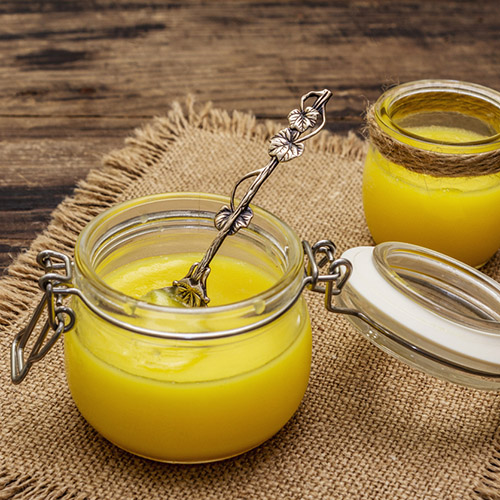How To Make Ghee ?

Introduction
Ghee, also
known as clarified butter, is commonly utilized in Ayurvedic medicine and
Indian cuisine. It is prepared by boiling butter and separating the pure
butterfat from the water and milk particles. The end result is a golden,
fragrant liquid with a deep, nutty flavor. Ghee boasts a long historical legacy
within the Indian cultural context. It is highly valued for its flavor,
excellent shelf life, and numerous health advantages.
Qualities
of Ghee
In Ayurveda,
cow ghee is referred to as Amritam due to its exceptional properties and
qualities.
1. Organic ghee has
a distinct, delectable flavor with a nutty, and caramel-like scent. It enhances
the flavor of food and gives it a deep, savory element.
2. Ghee has a very
high smoke point, which allows it to be cooked to a higher temperature before
it begins to burn. Due to its ability to resist high heat without degrading, it
is perfect for frying, sautéing, and deep-frying.
3. Ghee has a
longer shelf life than butter since the milk solids and water have been
removed. Ghee can survive for several months without refrigeration if it is
carefully preserved in an airtight container.
4.
Ghee is lactose
and casein-free. People who are lactose intolerant or sensitive to dairy
proteins are found to handle ghee well. The clarification process removes the
majority of the lactose and casein, making it a viable alternative for people
who avoid normal butter.
5. In Ayurveda, ghee
is revered for its therapeutic qualities. It aids in digestion, supports mental
performance, hydrate the body, and balance specific doshas (energies).
6. Ghee has a variety of culinary
applications in Indian cuisine, including curries, dals (lentil soups), rice
dishes, desserts, and even as a spread for bread or toast. Additionally, it is
used to add richness to sauces, temper spices, and improve the flavor of
numerous dishes.
Why is
ghee a great cooking fat?
Ghee is
considered an exceptional cooking fat due to several attributes that render it
especially suitable for various culinary methods. Ghee is preferred in culinary
applications for the following reasons:
1) High Smoke Point: Ghee typically
exhibits a range of 400°F to 485°F (200°C to 252°C), contingent upon its
quality and preparation. Its high smoke point enables it to withstand elevated
temperatures without undergoing combustion or degradation, rendering it an
ideal choice for culinary techniques that involve high-heat cooking, such as
sautéing, stir-frying, deep-frying, and roasting.
2) Enhancement of flavor: Ghee gives
food a rich, nutty flavor that improves both taste and scent. Butter's flavor
profile is enhanced throughout the process of generating ghee, making it a
preferred option for enhancing the depth and richness of various recipes.
3) Benefits for the digestive system:
Ghee is believed to be soothing to the digestive system according to Ayurveda.
It is believed to improve digestion and the absorption of nutrients from food.
Some people who might be lactose or casein sensitive may find that ghee is
easier for them to digest because milk solids are removed during the
ghee-making process.
Ghee is believed to have originated from the Indus Valley
approximately 8,000 years ago. It is considered a fundamental ingredient in the
pantry of South Asian households. In recent times, the utilization of ghee has
gained momentum in the Western world also.
Learn how to make ghee at home.
How to make ghee at home?
To make desi ghee at home, follow these instructions
step-by-step.
1. Take a slab of unsalted butter to get
things started. You can also use salted butter. However, the flavor might be a
little different.
2. Melt the butter
by putting it in a big skillet or heavy-bottomed saucepan. Heat to a medium-low
flame.
3. Butter should be
simmered, meaning it should be melted gently without being stirred. Clarified
butter will appear in the middle, followed by milk solids on the bottom, and
froth will appear on top as it melts.
4. Skim off the
foam: To remove the foam that forms on the surface, use a wooden spoon or
spatula. The contaminants in the foam can be thrown away.
5. Continue to
simmer: Turn down the heat and let the butter melt slowly. The milk solids at
the bottom will start to turn golden brown as it continues to separate. As it
starts to develop, you'll smell something delicious. To avoid burning, the
butter must be watched carefully as it simmers. If required, adjust the heat to
maintain a gentle simmer.
6. To strain the
ghee, carefully pour the clarified butter through a fine-mesh strainer or
cheesecloth when the milk solids have gone a deep golden brown. This procedure
assures that the ghee will be pure, smooth, and solid-free.
7. Remove the milk solids:
After filtering, you will be left with a golden liquid called ghee; discard the
milk solids. The milk solids that the strainer captures can be thrown away or
utilized in other dishes.
8. Cool and store:
Let the ghee cool completely before putting it in an airtight container or
clean, dry glass jar. As ghee cools, it solidifies. To avoid spoiling, make
sure the container is dry and moisture-free. Ghee should be kept at room
temperature.
The process
of making ghee at home takes a significant amount of time and meticulous
attention to detail in order to prevent burning or scorching. The duration of
the procedure typically ranges from 20 to 30 minutes, contingent upon the
quantity of butter utilized and the level of heat employed. Always use caution
when dealing with hot liquids and utensils.
You can use
homemade desi ghee in a variety of recipes to give your food a rich experience.

 All Categories
All Categories



